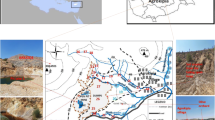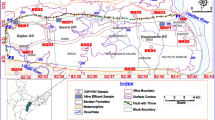Abstract
This study was designed to determine the extent to which alluvial and bedrock gold mining activities in the Kette-Batouri region of Eastern Cameroon are responsible for the discharge of potentially harmful elements (PHEs) into natural water bodies. This is considered to be of great public concern, since elevated levels of PHEs in these water bodies, which are widely used for domestic purposes, could have adverse health and environmental effects on the population and nearby ecosystems. The investigation into the levels of PHEs in natural water bodies of this area was conducted to ascertain the toxicity posed by mine waste stockpiles as data from the literature on this subject are scarce. Forty-two water samples from the region were analysed for some 60 PHEs by ICP-OES, of which 22 that were not below the detection limit were considered for further data analysis. Maximum total concentrations in water of As, Cr, Pb, and V and Zn are above the World Health Organization (WHO) maximum allowable concentration (MAC) levels and are as follows (μg l−1): As (21.90–50.9); Cr (1.80–57.30); Pb (0.50–34.70); V (24.70–77.20) and Zn (3.10–481.70). This information is consistent with that of our recent research efforts which have indicated moderate pollution by heavy metals in the soils with a slight deterioration of site quality in this region. The data generated from this investigation is important in the formulation of water management strategies and recommendations for remediation of water bodies at abandoned mine sites for meeting water quality standards.


Similar content being viewed by others
References
Asaah, A. V., Zoheir, B., Lehmann, B., Frei, D., Burgess, R., & Suh, C. E. (2014). Geochemistry and geochronology of the ~620 Ma gold-associated Batouri granitoids, Cameroon. International Geology Review. https://doi.org/10.1080/00206814.2014.951003.
Cheng, H., Hu, Y., Luo, J., Xu, B., & Zhao, J. (2009). Geochemical processes controlling fate and transport of arsenic in acid mine drainage (AMD) and natural systems. Journal of Hazardous Materials, 165, 13–26.
Drever, J. I. (1988). The geochemistry of natural waters (2nd ed.p. 402). Englewood Cliffs: Prentice Hall Inc.
Drever, J. I. (1997). The geochemistry of natural waters; Surface and groundwater environments (3rd ed.pp. 138–196). Upper Saddle River: Prentice Hall.
Edith-Etakah, B. T., Shapi, M., Penaye, J., Mimba, M. E., NguemheFils, S. C., Nadasan, D. S., Davies, T. C., & Jordaan, M. A. (2017). Background concentrations of potentially harmful elements in soils of the Kette-Batouri Region, Eastern Cameroon Research. Journal of Environmental Toxicology, 11(1), 40–54.
Ellen G., Loon J.W., Tolsma K. (1990). Heavy metals in vegetables grown in the Netherlands and in domestic and imported fruits. Z Lebensm Unters Forsch.190(1):34–39. https://doi.org/10.1007/BF01188261.
ERMITE. (n.d.) Environmental Regulations of Mine Water In the European Union FP5 http://citeseerx.ist.psu.edu/viewdoc/download?doi=10.1.1.1.4125&rep=rep1&type=pdf. Accessed 20 August 2017.
Ficklin, W.H., Plumlee, G.S., Smith, K.S., McHugh, J.B., 1992. Geochemical classification of mine drainages and natural drainages in mineralised areas, In: Kharaka, Y.K., Maest, A.S. (Eds.). Proceedings of 7th International Symposium, Water Rock Interaction, (pp. 381–384).
Fisher, R. S., & Mullican, F. W. (1997). Hydrochemical evolution of sodium-sulfate and sodium-chloride groundwater beneath the Northern Chihuahuan Desert, Trans-Pecos, Rexas, USA. Hydrogeology Journal, 10, 455–474.
Foumena, W.C., Bamenjo, J.N. (2013). Artisanal mining—a challenge to the Kimberly process: a case study of the Kadey Division, East Region of Cameroon. RELUFA Extractive Industries Programme Team, pp. 44, Available at http://www.relufa.org/documents/BOOKENGLISH_NET.pdf Accessed 24 Feb 2017.
Freeze, R. A., & Cherry, J. A. (1979). Groundwater (p. 604). Englewood Cliffs: Prentice-Hall.
Kelepertzis, E., Argyraki, A., & Daftsis, E. (2012). Geochemical signature of surface and stream sediments of a mineralized drainage basin at NE Chalkidiki Greece: a pre-mining survey. Journal of Geochemical Exploration, 114, 70–81.
Kumar, M., & Puri, A. (2012). A review of permissible limits of drinking water. Indian Journal of Occupational and Environmental Medicine, 16(1), 40–44.
Kumar, M., Kumari, K., Ramanathan, A., & Saxena, R. (2007). A comparative evaluation of groundwater suitability for irrigation and drinking purposes in two intensively cultivated districts of Punjab. India Journal of Environmental Geology, 53, 553–574.
Markewitz, D., Davidson, E. A., Figueiredo, R. O., Victoria, R. L., & Krusche, A. V. (2001). Control of cation concentrations in stream waters by surface soil processes in an Amazonian watershed. Nature, 410, 802–805.
Mimba M.E., Ohba T., Nguemhe Fils S.C., Nforba M.T., Numanami N.,Bafon T.G.,Aka F.T.,Suh C.E.. (2018). Regional geochemical baseline concentration of potentially toxic trace metals in the mineralized Lom Basin, East Cameroon: a tool for contamination assessment. Geochemical Transactions 19:11, 19–32.
Meybeck, M. (1987). Global chemical weathering of surficial rocks estimated from river dissolved loads. American Journal of Science, 287, 401–428.
Smedley, P. L., & Kinniburgh, D. G. (2002). A review of the source, behaviour and distribution of arsenic in natural waters. Applied Geochemistry, 17, 517–568.
Srinivasamoorthy, K., Chidambaram, S., Prasanna, M. V., Vasanthaviha, M., Peter, J., & Anandhan, P. (2008). Identification of major sources controlling groundwater chemistry from a hard rock terrain—a case study from Mettur taluk, Salem district, Tamil Nadu. Journal of Earth System Science, 117, 49–58.
Stumm, W., & Morgan, J. J. (1981). Aquatic chemistry, an introduction emphasising chemical equilibria in natural waters (2nd ed.pp. 526–538). New York: Wiley.
Suh, C. E., Lehmann, B., & Mafany, G. T. (2006). Geology and geochemical aspects of lode gold mineralization at Dimako-Mboscorro, SE Cameroon. Geochemistry: Exploration, Environment, Analysis, 6, 295–309.
Toteu, S. F., Penaye, J., & Poudjom, D. Y. (2004). Geodynamic evolution of the Pan-African belt in Central Africa with special reference to Cameroon. Canadian Journal of Earth Sciences, 41, 73–85.
Toteu, S. F., Penaye, J., Deloule, E., Van Schmus, W. R., & Tchameni, R. (2006). Diachronous evolution of volcano-sedimentary basins north of the Congo craton: insights from U–Pb ion microprobe dating of zircons from the Poli, Lom and Yaounde Series (Cameroon). Journal of African Earth Sciences, 44, 428–442.
Van Schmus, W. R., Oliveira, E. P., Da Silva Filho, A. F., Toteu, S. F., Penaye, J., Guimaraes, I. P. (2008). The Central African Fold Belt Proterozoic Links between the Borborema Province, NE Brazil, and the Central African Fold Belt (pp. 69–99). London: Geological Society, Special Publications 294.
Vishiti, A., Suh, C. E., Lehmann, B., Egbe, J. A., & Shemang, E. M. (2015). Gold grade variation and particle microchemistry in exploration pits of the Batouri gold district, SE Cameroon. Journal of African Earth Sciences, 111, 1–13.
World Health Organization (1999). The World Health report: making a difference, Geneva, Switzerland. ISSN 1020–331. (NLM Classsification: WA 540–1).
World Health Organization (WHO) (2006) Concise International Chemical Assessment Document 69 Cobalt and inorganic cobalt compounds, Geneva, Switzerland (pp. 8–53). (http://www.who.int/ipcs/publications/cicad/cicad69%20.pdf) Accessed (06 December 2017).
World Health Organization (WHO) (2011), Guidelines for drinking-water quality, [Chapter 12] Chemical fact sheets, fourth edition, Geneva, Switzerland, p 564.
Zayed, A.M., Terry, N. (2003). Chromium in the environment: factors affecting biological remediation Plant. Plant Soil. 249:139–156.
Acknowledgments
The professionalism shown by ACME Laboratories in Vancouver, Canada, in performing analytical work of the highest quality is also gratefully acknowledged.
Funding
This study was supported by funding from the 2013 Swedish International Development Agency (SIDA)/IGCP/UNESCO Project 606 grant. Further support for this work came from the Centre for Geological and Mining Research, Garoua, Cameroon, as well as the Research Directorate and the Faculty of Natural Sciences of Mangosuthu University of Technology, South Africa.
Author information
Authors and Affiliations
Corresponding author
Electronic supplementary material
ESM 1
(DOCX 129 kb)
Rights and permissions
About this article
Cite this article
Jordaan, M.A., Mimba, M.E., NguemheFils, S.C. et al. Occurrence and levels of potentially harmful elements (PHEs) in natural waters of the gold mining areas of the Kette-Batouri region of Eastern Cameroon. Environ Monit Assess 190, 416 (2018). https://doi.org/10.1007/s10661-018-6777-1
Received:
Accepted:
Published:
DOI: https://doi.org/10.1007/s10661-018-6777-1




